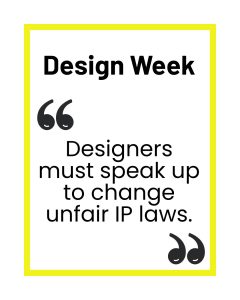

Unregistered Community design right
The level of protection afforded to designers by the EU’s unregistered Community design (UCD) right is significantly higher than that of the UK equivalent,[1] however repeated commitments from Government have gone some way to assure designers that an equivalent level of protection will be introduced post-Brexit by the introduction of the Supplementary Unregistered Design Right as set out in a draft Statutory Instrument introduced into Parliament on 31 January 2019. This SI has not yet been passed or implemented, however.
However, even if equivalent protection (that is, a new or improved UK right) is achieved through this Si, the design sector will still be gravely at risk without reciprocal protection (that is, from the EU27). Post-Brexit, designs first disclosed in the UK, while they may well be sufficiently protected here, will incur no UCD protection in the EU if first publication of that design occurs in the UK, because the UK will no longer be a member of the EU and it is an absolute requirement of the EU protection for first publication to take place in an EU member state.[2]
This would have grave consequences for UK designers, almost 80% of whom rely on the UCD right to protect their designs, according to a recent survey by Anti-Copying in Design (ACID).[3] The EU is largest export market for many UK design sectors, contributing for example over two thirds of UK furniture manufacturers’ export revenue.[4]
Such a loss of reciprocity also poses a serious threat to leading industry events, such as 100% Design, London Fashion Week, Spring & Autumn Fair and Top Drawer, at which creators from all over the world come to the UK to reveal new and innovative designs. Without protection designers will either have to run the risk of copying throughout the EU27 following disclosure, or simply avoid first disclosure in the UK altogether.
In a response to a question on design rights in October 2017, the then Minister for IP, Jo Johnson, stated: “We are exploring various options and we are discussing these with users of the system to establish the best way forward.” This offered no certainty to designers, and in the absence of any real progress since then, more detailed assurances from Government are necessary.
Despite repeated questioning to senior officials at the IPO, designers have been told to take legal advice on this matter. The least they can expect however is some guidance let alone leadership from Government on this crucial issue.”
Dids Macdonald, CEO of ACID & Vice Chair of the Alliance for IP said, “We were pleased to be able to supply strong and compelling ACID evidence to the IPO to demonstrate the necessity to address the need for the Supplementary Unregistered Design Right in the UK and it is at least a step in the right direction that they acted upon this but it is not nearly enough to protect UK designers deal or no deal when we leave the EU.”
Nick Kounoupias, ACID Chief Counsel said, “We require an explicit assurance from Government that it is endeavouring to attain reciprocity on unregistered design rights as a high priority during upcoming negotiations. The design sector will still be gravely at risk without reciprocal protection (that is, from the EU27). Post-Brexit.”
[1] http://mewburn.com/resource/uk-eu-unregistered-designs-the-basics/
[2] A Q&A document published by the EUIPO on 30 January 2018 made this point quite unequivocally when it stated that the UDC right’s “territorial scope of protection ceases to extend to the UK as from the withdrawal date” https://euipo.europa.eu/tunnel-web/secure/webdav/guest/document_library/contentPdfs/news/QandA_brexit_en.pdf
[3] According to Alliance member ACID a number of reasons for this are reported, including scale of output, registration costs, legal costs and a lack of confidence in registration as a defence against copying.
[4] http://britishfurnitureconfederation.org.uk/about-the-industry/
Spread the Word

Latest News





Newsletter Sign-Up
| Cookie | Duration | Description |
|---|---|---|
| cookielawinfo-checkbox-analytics | 11 months | This cookie is set by GDPR Cookie Consent plugin. The cookie is used to store the user consent for the cookies in the category "Analytics". |
| cookielawinfo-checkbox-functional | 11 months | The cookie is set by GDPR cookie consent to record the user consent for the cookies in the category "Functional". |
| cookielawinfo-checkbox-necessary | 11 months | This cookie is set by GDPR Cookie Consent plugin. The cookies is used to store the user consent for the cookies in the category "Necessary". |
| cookielawinfo-checkbox-others | 11 months | This cookie is set by GDPR Cookie Consent plugin. The cookie is used to store the user consent for the cookies in the category "Other. |
| cookielawinfo-checkbox-performance | 11 months | This cookie is set by GDPR Cookie Consent plugin. The cookie is used to store the user consent for the cookies in the category "Performance". |
| viewed_cookie_policy | 11 months | The cookie is set by the GDPR Cookie Consent plugin and is used to store whether or not user has consented to the use of cookies. It does not store any personal data. |